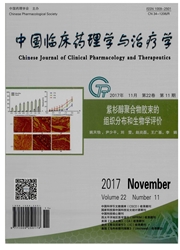

 中文摘要:
中文摘要:
目的:以聚乙烯亚胺(polyethyleneimine,PEI)为载体,将硫代寡聚脱氧核苷酸(PS-ODNs)转染到耐甲氧西林金黄色葡萄球菌(methicillin resistant staphylococcus aureus,MRSA)体内,通过药效学观察PS-ODNs逆转MRSA对β-内酰胺类抗生素的耐药性。方法:制备PEI与PS-ODNs结合的纳米微粒(PEI-ODNs纳米微粒);PEI-ODNs纳米微粒的粒径分析及结合率的测定;平板克隆形成实验计数菌落数(CFU);微量法测定细菌生长曲线;液体稀释法测定细菌的最小抑菌浓度(MIC)。结果:PEI-ODNs纳米微粒的粒径为(85±22)nm,PEI与PS-ODNs的结合率最高为(97.3±1.1)%。含苯唑西林(6mg/L)的M-H琼脂板上,30μg/mL的PEI-ODNs纳米微粒组MRSA的菌落数为6.4×10^8/mL,而空白对照组的菌落数为3.3×10^9/mL,二者相比给药组菌落数明显减少,差异具有统计学意义(P〈0.01),而其他对照组与空白对照组比较差异无统计学意义。实验结果显示PEI-ODNs纳米微粒组的苯唑西林对MRSA生长有抑制作用,30μg/mL的PEI-ODNs纳米微粒可将苯唑西林对MRSA最小抑菌浓度由1024μg/mL降低至16μg/mL。结论:PEI与PS-ODNs的结合率很高且粒径较小,PS-ODNs可以部分逆转MRSA对β-内酰胺类抗生素的耐药性。药效学结果显示PEI可以有效地将反义寡核苷酸转入MRSA体内,可考虑将其作为反义寡核苷酸进入细菌的载体。
 英文摘要:
英文摘要:
AIM: This study used polyethyleneimine (PEI) and phosphothioate oligedeoxynucleotide (PS-ODNs) to prepare PEI-ODNs nanometer particle and transmit it into methicillin resistant staphylococcus aureus (MRSA) in vitro by pharmacodynamic evaluation. METHODS: The PEI-ODNs nanometer particle was prepared and its diameter was analyzed. The PEI and PS-ODNs binding rate by fluorospectrophotometer was evaluated. The total colony forming unit (CFU) was counted. The cell growth curve was drawn by measuring A630nm at different time points with microplate reader. The minimal inhibitory concentration (MIC) was determined by fluid dilution method. RESULTS: The diameter of PEI-ODNs nanometer particle was (85±22) nm and the highest binding rate was (97.3±1.1 ) %. In M-H agar plate( including 6 μo/mL oxacillin), the number of MRSA colonies was 6.4×10^8/mL in 30 μg/mL PEI-ODNs nanometer particle treated group, while the number of MRSA colonies in blank control was 3.3×10^9/mL. The number of MRSA colohies was significantly decreased in PEI, ODNs nanometer particle treated group ( P 〈 0.01 ), while CFU of MRSA was not influenced in control group (P 〉 0.05). Significant growth inhibition of cells treated with PEI-ODNs nanometer particle was observed as compared with those cells in control. The MIC of oxacillin to MRSA was decreased from 1 024 μg/mL to 16μg/mL when treated with 30 μg/mL PEI-ODNs nanometer particle. CONCLUSION: PEI binds PS-ODNs with high binding rate and has little diameter. The susceptibility of MRSA to β-lactam antibiotics is significantly restored. The results indicate that the PEI can transmit PS-ODNs into MRSA and it is considered as a new vector for PS-ODNs into bacteria.
 同期刊论文项目
同期刊论文项目
 同项目期刊论文
同项目期刊论文
 期刊信息
期刊信息
